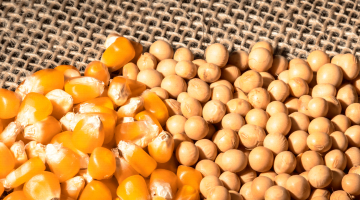The highest mortality rate is registered on the first week
In addition to the concern with the physical space, temperature and other biosecurity factors of barns, where chicks are housed on the first week of life, the nutritional balance of the broilers feeding is directly related to the profitability of the producer.
As the species originally feed on everything, from grains to small insects and other animals, the diet of chickens has evolved in several ways, according to the physical adaptations of the species.
For broilers, specific feed for each stage is recommended. The feed is developed to meet nutritional demands, mainly regarding the amount of energy and protein, as in the post-hatching stage, when the chick moves from the embryonic phase to the rearing phase, starting to consume balanced diets.
A balanced diet must reach the goals of each farmer. However, we can consider essential the supplementation of free nucleotides and nucleosides, functional carbohydrates, short-chain polypeptides, free amino acids, among others, which will reflect on better development and performance of animals and will stimulate a more efficient immune response.
Nutrition and Development of Broilers
Physical conditions of broilers is a key factor for the profitability of farmers. Underweight broilers, with underdeveloped breast and thigh, are animals that had nutritional problems early in life. In this case, the first ten days are considered as the main period to develop these aspects.
Since they lack taste buds, feeding broilers, mainly in the first week of life, is a sensory challenge. Besides, the first food must be highly palatable – this is a unanimous opinion among technicians and experts in animal nutrition.
In the first days of life, the gastrointestinal tract of broilers is anatomically developed, but still in a physiological state of maturation, reaching full function at the end of ten days of age. For this reason, feeding broilers in the early days with diets that stimulate this maturation will ensure better functionality of the gastrointestinal tract and, consequently, better performance throughout production.
Challenges and Solutions
Food safety is a latent concern in the livestock industry because it reflects the quality of the final product. As a consequence, natural and efficient additives are increasingly demanded by the consumer market.
Hilyses® is an additive well accepted by younger animals – such as chicks in the post-hatching phase. As a nutritional component, used in feed, Hilyses® stimulates a more efficient immune system response in animals at this development phase by enhancing cell multiplication, thus positively influencing metabolism and tissue growth.
Hydration is an important part of the diet, especially in the first week. It is a cyclical process. As they produce little saliva, broilers need to consume more water.
To obtain positive results at the end of the production, farmers must meet nutritional needs of animals, mainly in the first week of life. Management, sanity, and welfare of animals are also of major importance. This set of factors ensures quality at the end of production, better profitability, and food safety in every stage.
Posted in 26 September of 2019


